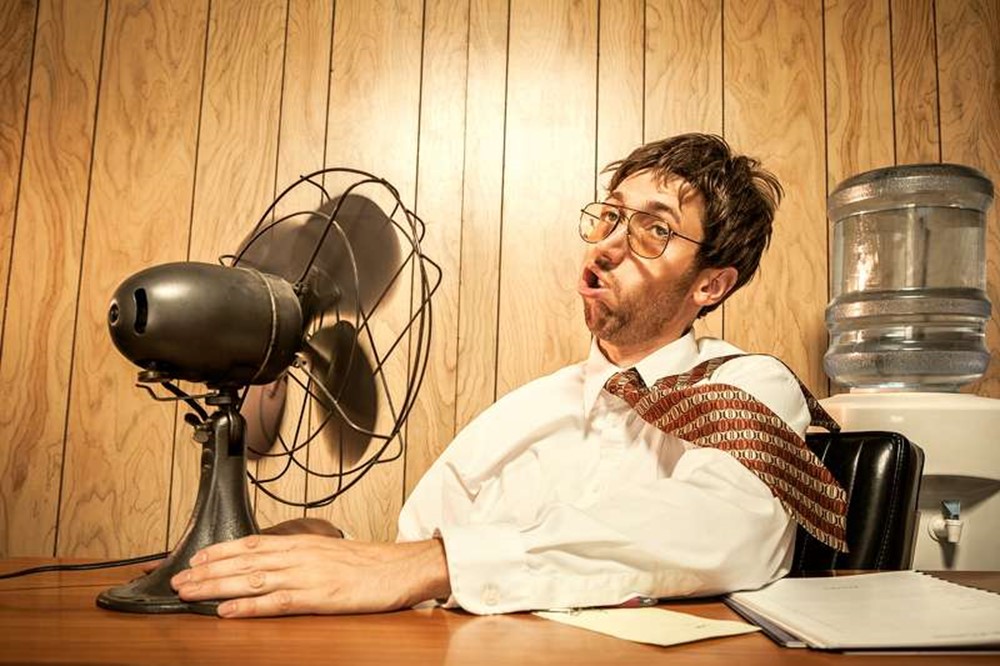Heat in the workplace – temperatures will continue to rise, even in temperate areas
No matter what the thermometer in the office shows: there is no such thing as heat-free for employees. When temperatures in the classroom climb above 30 degrees, children and young people in Germany are usually released from school lessons - which is probably what many employees want in the hot summer months. Unfortunately, there is no right to be heat-free in offices, shops, warehouses or universities.
At certain temperatures, however, the employer must ensure cooling down or the appropriate PPE to prevent this from happening. If you as an employer really want to do something beyond that, provide your employees with free water dispensers or bottled water - it doesn't cost much, but it is easily accessible. And by the way, adjusting clothing expectations in summer is free. PPE can also be suitable for summer – but it costs a little.
And so that you are protected in the event of heat-related accidents –simply instruct your workforce, quickly and cost-effectively with HSE 4.0 – e-learning for medium-sized businesses.
Summer not only brings sunshine and leisure activities, but also oppressive heat, which makes everyday work a challenge. While students get some heat relief in extreme temperatures, workers continue to toil. But what does this mean for occupational safety? What obligations do companies have to protect their employees from the health risks of heat? In this article we look at the legal basis, employers' responsibilities and practical measures to ensure a safe workplace.
Legal basis
Labor law regulations
There is no specific regulation in German labor law that grants employees heat exemption. This means that workers must work in extreme temperatures if working conditions permit. But that doesn't mean employers don't have responsibilities.
No entitlement to heat-free
Despite the lack of legal regulations for heat-free, employers are obliged to protect the health of their employees. This results from the general duty of care, which is anchored in the Civil Code (BGB) and the Occupational Safety and Health Act (ArbSchG).
Responsibility of employers
Duty to care
Employers have a legal duty of care. This means they must ensure that working conditions do not pose any health risks to their employees. Appropriate protective measures must therefore be taken at high temperatures.
Measures to protect employees
There are several measures employers can take to protect their employees from the heat. These range from organizational changes to technical solutions and personal protective equipment.
Legal regulations regarding room temperature
Technical rules for workplaces (ASR)
The Technical Rules for Workplaces (ASR A3.5) provide recommendations for room temperature. Accordingly, the room temperature in work rooms should not exceed 26 degrees Celsius. However, at higher outside temperatures, up to 35 degrees Celsius can be tolerated if appropriate measures are taken.
Maximum room temperatures
If the room temperature exceeds 35 degrees Celsius, the room is unsuitable for work activities. In such cases, measures to reduce the temperature or adjust the working conditions are mandatory.
Practical protective measures
Adjustment of working hours
One way to beat the heat is to adjust your working hours. Early shifts or late shifts can help avoid the hottest hours of the day.
Air conditioning and fans
Technical aids such as air conditioning and fans are effective measures to reduce the room temperature and ensure cooling.
Providing water and shade
Employers should provide sufficient drinking water and provide shaded break areas to allow employees to relax.
Dress code relaxation
A flexible dress code that allows for lighter, airier clothing can also help reduce exposure to the heat.
Health risks from heat
Heat stroke and heat exhaustion
High temperatures can lead to serious health problems such as heat stroke and heat exhaustion. Both conditions require immediate medical attention and can be life-threatening.
Dehydration and sunburn
In addition to heat stroke, other risks that can arise from high temperatures in the workplace are dehydration and sunburn. Both conditions can affect long-term health.
Signs and symptoms of heat stress
Early detection of heat stress
It is important to recognize the signs of heat stress early. Symptoms can include headaches, dizziness, nausea and muscle cramps.
Emergency measures
In the event of heat stress, immediate measures should be taken to cool and rehydrate the affected person. If symptoms are severe, an emergency doctor should be called.
Special protection needs of certain groups of workers
Pregnant women
Pregnant women are particularly sensitive to heat and need special protective measures to avoid overheating.
Older employees
Older employees are often at higher risk of heat-related health problems and should therefore be given special protection.
Employees with previous illnesses
People with chronic illnesses such as cardiovascular problems or diabetes are also more susceptible to heat-related complications.
Workplace design
Ergonomic adjustments
Ergonomic adjustments in the workplace, such as the use of height-adjustable desks and ergonomic chairs, can help reduce heat exposure.
Shade providers and sun protection films
Shades such as awnings and sun protection films on windows can help reduce direct sunlight and lower the room temperature.
Education and awareness raising
Training for employees
Regular training on heat protection and first aid can help raise employees' awareness of the risks and measures.
The information campaign
Information campaigns within the company can also help inform employees about the dangers of heat and the necessary protective measures.
Role of works councils
Co-determination rights
Works councils have co-determination rights when it comes to shaping working conditions. You can therefore play a key role in the implementation of heat protection measures.
Collaboration with company management
Close cooperation between works councils and company management is crucial in order to develop and implement effective protective measures.
Best practice examples
Company with exemplary heat protection
There are companies that have already implemented exemplary heat protection measures. These examples can serve as inspiration and show that effective protection is possible.
Successful measures and their effects
Successful measures such as the installation of air conditioning or flexible working hours have proven themselves in practice and can significantly improve the health and satisfaction of employees.
Future prospects
Climate change and rising temperatures
With climate change, rising temperatures and more frequent heat waves are to be expected. Companies must therefore prepare for these changes in the long term and develop appropriate strategies.
Adaptation strategies for the future
Adaptation strategies include long-term investments in climate-friendly technologies, sustainable building design and ongoing employee training.
conclusion
In summary, no employee in Germany has a legal right to be heat-free. Nevertheless, companies are obliged to protect their employees from the dangers of heat. Through a combination of technical, organizational and personal protective measures, employers can help ensure the health and well-being of their employees. Climate change presents us with new challenges that we can only overcome together.
FAQs
What rights do employees have in extreme heat?
Employees do not have a legal right to be heat-free, but they can request protective measures such as adjusted working hours or cooling options.
What are the best protective measures against heat in the workplace?
The best protective measures include air conditioning, fans, flexible working hours, sufficient drinking water and adjusted dress codes.
How can employees help themselves cool down?
Employees can help cool down by regularly drinking water, wearing light clothing and taking breaks in the shade.
What obligations do employers have during heat waves?
Employers are obliged to take measures to protect their employees, including technical, organizational and personal protective measures.
What should you do if you experience heat stress?
If you experience heat stress, you should take immediate steps to cool and rehydrate the affected person and call emergency medical attention if symptoms are severe.
Source: Stiftung Warentest









